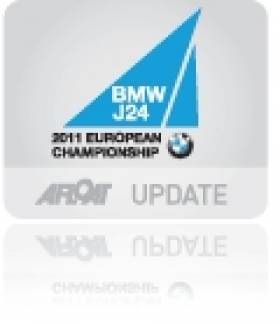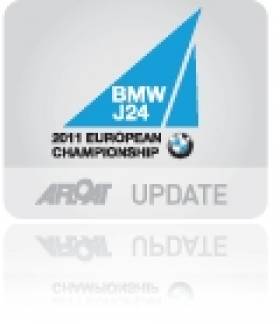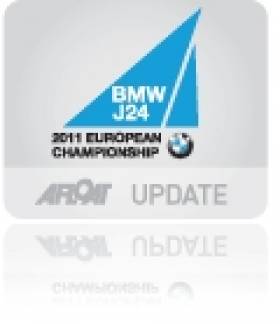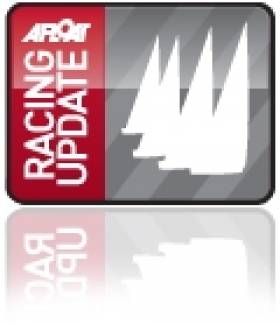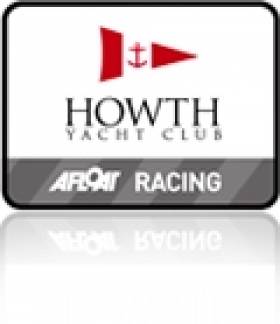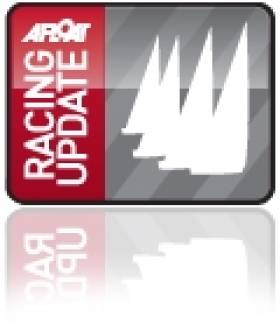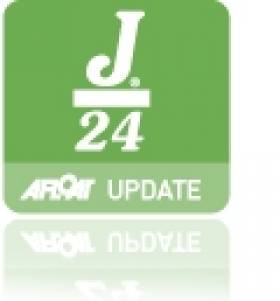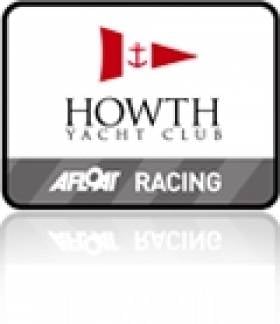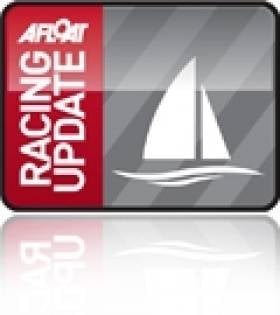Displaying items by tag: J24
Penfold Wins J24 Euro Title in Last Race Decider
Top of the table was 'Reloaded' (Mark Penfold), sailing under US colours, with 34 points, three ahead of the leading European entry 'Il Riccio' (Ian Southworth/Chris McLaughlin) which takes the European Championship trophy.
With the exception of their discard of a 20th in the fifth race, 'Reloaded' was consistently in the top four in most races and had one bullet, while closest rivals 'Il Riccio' had two bullets and only a 9th to discard.
That they had some 28 points to spare over the third placed 'Serco' (Bob Turner) emphasised their dominance over the series. The German champion 'Rotoman' (Kai Mares) was only a point behind in 4th place and won the final race of the regatta while Stuart Jardine, the oldest helm in the championship, had the distinction of winning three races, including the first two races of the final day. Another German boat 'Hungriger Wolf' (Johann Huhn) had six top ten results to earn 6th overall.
Local boat Jibberish (O'Kelly/Wormald/Walsh) enjoyed its best result when finishing second behind 'Stouche' (Jardine) in the seventh race while German entry 'JJone' (Frithjof Schade) was looking at the same transom in the eighth race. The Southworth/McLaughlin crew topped the fleet in the penultimate race followed by the Hungarian boat 'Naviscon' (Farkas Litkey) while 'Serco' took second behind 'Rotoman' in the final race.
Needing to beat their US rivals by several places in the last race to take 1st overall, 'Il Riccio' could only manage an 8th to 'Reloaded's' 5th.
The leading Irish crew was 'Hard on Port' (Flor O'Driscoll, HYC) in 10th overall with 'Jamais Encore' (John-Patrick McCaldin, Lough Erne YC) next best in 17th.
J24 Euros Open in Howth, Strong Winds Cancel Practise Race
The BMW J/24 European Championships were officially opened last night with a ceremony on the forecourt in front of the Howth Yacht Club clubhouse on the podium erected by the sponsor but a practise race scheduled for this afternoon was cancelled due to strong winds.
Last night's openning ceremony featured two top-of-the range BMW vehicles and a motorcycle and a backdrop with the highly appropriate phrase of 'Joy is Plain Sailing' in front of the national flags of the nine competing nations.
With an audience of competitors, supporters and club members, the speakers on the podium were introduced by the 'Master of Ceremonies', Club and Championship Press Officer Graham Smith.
First to speak was Derek Bothwell, Chairman of the Championship Organising Committee, and then the Commodore Roger Cagney addressed the large crowd who has assembled on the forecourt and balcony. They were followed by John Ives, Managing Director of BMW Ireland, the title sponsors, who spoke about BMW's global involvement in sailing, and then Niamh McCutcheon, President of the Irish Sailing Association, spoke on behalf of the ISA and the Irish Sports Council who supported the event.
Jim Farmer, President of the World Council of the International J/24 Class Association, spoke next, and the final speaker was the Mayor of Fingal, Cllr.Gerry McGuire, who welcomed all the overseas visitors to the county and officially declared the Championship open.
42-boat fleet for BMW J24 Europeans at Howth
Over 200 sailors from nine countries will compete in the BMW J24 European Championships which start at Howth Yacht Club next Monday (12th), hard on the heels of the Star Europeans in Dublin Bay.
Measurement and registration take place between this Friday and the practice race on Sunday, with the 10-race series concluding on Thursday 15th. Forty-two boats have entered the championship, with Irish and British entries accounting for 14 and 13 boats respectively, eight from Germany, two from Italy and one each from the USA, Holland, France, Greece and Hungary.
Six of the top eight finishers in the recent UK Championships at Weymouth will be in action, with the winner (and defending European Champion) ‘Serco’ (Bob Turner), helmed by Nathan Batchelor, and 3rd-placed ‘Stouche’ (class veteran Stuart Jardine) leading the charge.
Second at Weymouth was ‘Reloaded’ which a multi-national crew will sail under US colours. American sailmaker Mike Ingham will helm the boat owned by Englishman Mark Penfold (trimmer) with a Swedish bowman, Scottish tactician and a Danish cockpit man! Ingham is a former North American champion and was runner-up in the Worlds four years ago.
Leading the Irish challenge will be Flor O’Driscoll and the crew of ‘Hard On Port’ (RStGYC/HYC) who recently retained their national crown at Lough Erne and also won the season’s two regionals at Lough Ree and Malahide. Other local contenders will include ‘Murder Picture’ (Mickey McCaldin, LEYC), ‘Jamais Encore’ (JP McCaldin, LEYC), ‘Jibberish’ (Fergus O’Kelly & Others, HYC), ‘Carrabeg 2’ (Stefan Hyde, RCYC) and ‘Sayonara’ (Murphy/Darrer, HYC).
“We are pleased with the entry,” said Organising Committee Chairman Derek Bothwell, “as it will provide good competitive racing afloat and at the same time act as a welcome boost to the local economy with so many overseas visitors.”
PRO for the BMW J24 Championships is the highly experienced IRO David Lovegrove and the schedule starts with three back-to-back races next Monday.
Racing Round up: Olympic, Fastnet, Clipper, Figaro, Dragon, J24, Fifteen, Topper, Feva, Oppy
This morning's edition includes photos and pics from Sunday's Figaro departure from Dun Laoghaire and the Rick Tomlinson's pics of the start of the Fastnet race from Cowes. Derry-Londonderry is on her way to Rio in the Clipper race. Regrettably there was no Gold, Silver or Bronze from Weymouth but we're in a strong position. See our video with Annalise here. Plus: The Topper Worlds at the National YC, John Lavery's win at the Flying fifteen South coast champs in Dunmore East, the J24 Nationals from Lough Erne, A local pair whitewashed the RS Feva Nationals in Cork Harbour, some great shots from Bob Bateman. The Oppy Nationals start in Howth and Afloat's Sailor of the Month for July Martin Byrne retained the Dragon Nationals in Kinsale. There's also the full weekend results from Dublin Bay SC.
Howth Yacht Club Lays Out 2011 Sailing Programme
At a launch reception in the club on Thursday 31st March attended by representatives of local commerce, tourism and community bodies, HYC Commodore Roger Cagney announced that in addition to junior and adult sail training courses and club racing four days a week in the summer months, the Club would host over 20 open events during the year.
"We are used to sailing being a year-round activity," he said, "but even by our standards this will be an exceptionally busy year for Howth Yacht Club. We are fortunate in the number of talented volunteers we can call upon to help make these events successful and we have an enviable track record in this regard. We are also extremely grateful for the sponsorship of individual events from commercial concerns, details of which will be released in due course."
The major event on the 2011 calendar is undoubtedly the European Championship of the J24 Class, the world's most popular racing keelboat, when over 200 sailors from six or more countries will compete in the four-day regatta in September.
Howth will also host the Irish Championships of four classes – Puppeteer, Squib, Howth 17 and Optimist – between July 1st and late-August, with the latter attracting up to 200 competitors, together with their families, coaches and supporters. In addition, HYC will run the SB3 Eastern Championships (end April), the RS Feva Leinsters (late May) and the Dublin Match Racing Open (in J80s in early September).
The club's programme also comprises the Spring Warmer series in April, the annual Lambay Races on June 11th, the Dinghy Regatta a week later and the ever-popular Autumn League over five weekends in September/October.
Elida Wins Class One of SCORA Championships
It was one of those weekends in Cork Harbour where the wind refused to play the game writes Claire Bateman. All was prepared and in readiness at Cove sailing Club for the McWilliam One Sail SCORA South Coast Championships on Saturday morning. They had the committee boat, the support RIBS, the marks and last but certainly not least they had acquired the services of the hard working Neil Prendeville as the PRO.
Setting up the committee boat off "Foxes Cover" in about 6 knots of wind the Race Officer sent off the fleets who started with great enthusiasm but alas and alack this wind did not hold but was quite happy to die and fill in again from a different direction only to die once more, making it a frustrating day for the sailors.
Sunday, if anything, was worse with the wind boxing the compass. Despite the lack of wind the fleets did manage to complete one shortened round thus enabling a result for the Championships.
OVERALL RESULTS:
In Class One IRC Ria Lyden in Elida was first with Colman Garvey in True Pennance second. This situation was repeated in ECHO.
In Class Two IRC Vinnie Delaney's Yanks & Ffrancs was first with the other Corby 25 Denis Coleman's Thunderbird second.
In Class Two ECHO Yanks & Ffrancs again prevailed with Leonard Donnery's No Gnomes in second place.
In Class Three IRC Niall Kelly's WOT Like took first place with Dominic Losty's Woody second.
In Class Three ECHO it was Fergus Coughlan's White Knight took the win followed by Liam and Pat Coakley's J24 JAY.
In Class Four IRC Two GK 24s fought it out with Mike Sexton's Granny Knot beating Kevin O'Connell's Gaelic Kiwi into second place.
In Class Four ECHO Granny Knot again took the win with Peter Webster's Thistle in second place.
McCaldin Defending Title in Style
His championship defence couldn't have started any better, with three successive bullets. The fourth race was something of a disaster for them finishing 14th but 5th in the final race of the first day sees them two points clear of their major rival for the honours, Flor O'Driscoll (RSt.GYC) on 'Hard on Port' who notched up three third places and a win the final race to stay very much in touch with the defending champion.
Local hopes centre on 'Jibberish' (O'Kelly & Co) and they did not disappoint. Having only taken delivery of the boat two days ago after repairs to serious damage suffered months ago in a T-bone collision, they might be excused for not performing, as they got re-0acquainted with their boat. A results card that included two second places and the most impressive race win of the day – the margin of victory was very impressive – puts the Howth crew in third place overall going into the second day.
Tying on points but ranked as 4th is J/24 Class President Robin Eagleson of Lough Erne YC on 'Luder Too' who also showed great consistency with three second places and might have ended the day even higher up the leader-board if it wasn't for a disastrous last race when the tides played havoc with the distinctively red boat at the windward mark.
Two other northern boats – JP McCaldin's 'Jamais Encore' (Dalgety Bay SC) and 'Sayonara' (D.O'Donovan, LEYC) – fill the next two places overall.
The five windward-leeward races were sailed in varying (although generally fresh) conditions, with headsail changes the order of the day, while the last race threw up gusts of 30 knots plus at the 17-boat fleet. The series concludes on Sunday 12th with three races scheduled by PRO David Lovegrove and his team on 'Free Enterprise'.
J/24 National Championship – overall places after 5 races:
Mickey McCaldin – LEYC – 8 points
Flor O'Driscoll – RStGYC – 10 points
Fergus O'Kelly & Co. – HYC – 14 points
Robin Eagleson – LEYC – 14 points
J.P. McCaldin (DBSC) – 20 points
D.O'Donovan – LEYC – 20 points
Photo Gallery by Gareth Craig HERE
Irish Teams Third and Fifth in New York
After 3 very intense days of international competition at the Dennis Connor International Yacht Club Challenge, the Irish teams consisting of Royal Cork Yacht Club finished 3rd, Howth Yacht club finished 5th overall beating some very talented opposition including the two local Manhattan Yacht Club teams.
The event was sailed in a fleet of J24's and the RCYC boat was skippered by Stefan Hyde and the Howth Boat by Emma McDonald.
In fact if it was not for a penalty after a collision in race 4 (Under Regatta rules, if a collision occurs, both boats have to do turns no matter who is in the right / wrong) and the cancellation of race 7 on the last beat due to a approaching thunderstorm - podium positions for both teams could have beckoned.
The regatta was sailed in the very busy waters of the Hudson river in New York City which along with the challenges of avoiding commercial traffic, some of the strongest currents that the crew have ever experienced had to be negotiated in varied winds from 5knts on the opening day to 30knts plus during approaching thunderstorms on the final day. The 3rd Irish team; Wexford Harbour Yacht and Tennis Club finished in 10th place.
The event was won by the team from Switzerland - Societe Nautique Rolloise followed one point behind by USA - Southern Yacht Club and then a fantastic 3rd place by the Irish team from Royal Cork skippered by Stefan Hyde.
It is tradition on presentation night that each team presents to the team that finishes behind them in the final results a humourous prize.
4th place Austrian team presented the HYC team with "Lederhosen".
Howth Yacht Club also presented Commodore Michael Fortenbaugh of Manhattan Sailing Club and Dennis Connor (Americas Cup Hero) with HYC Burgees.
A fantastic event in a wonderful city that certainly promoted international goodwill through friendly competition.
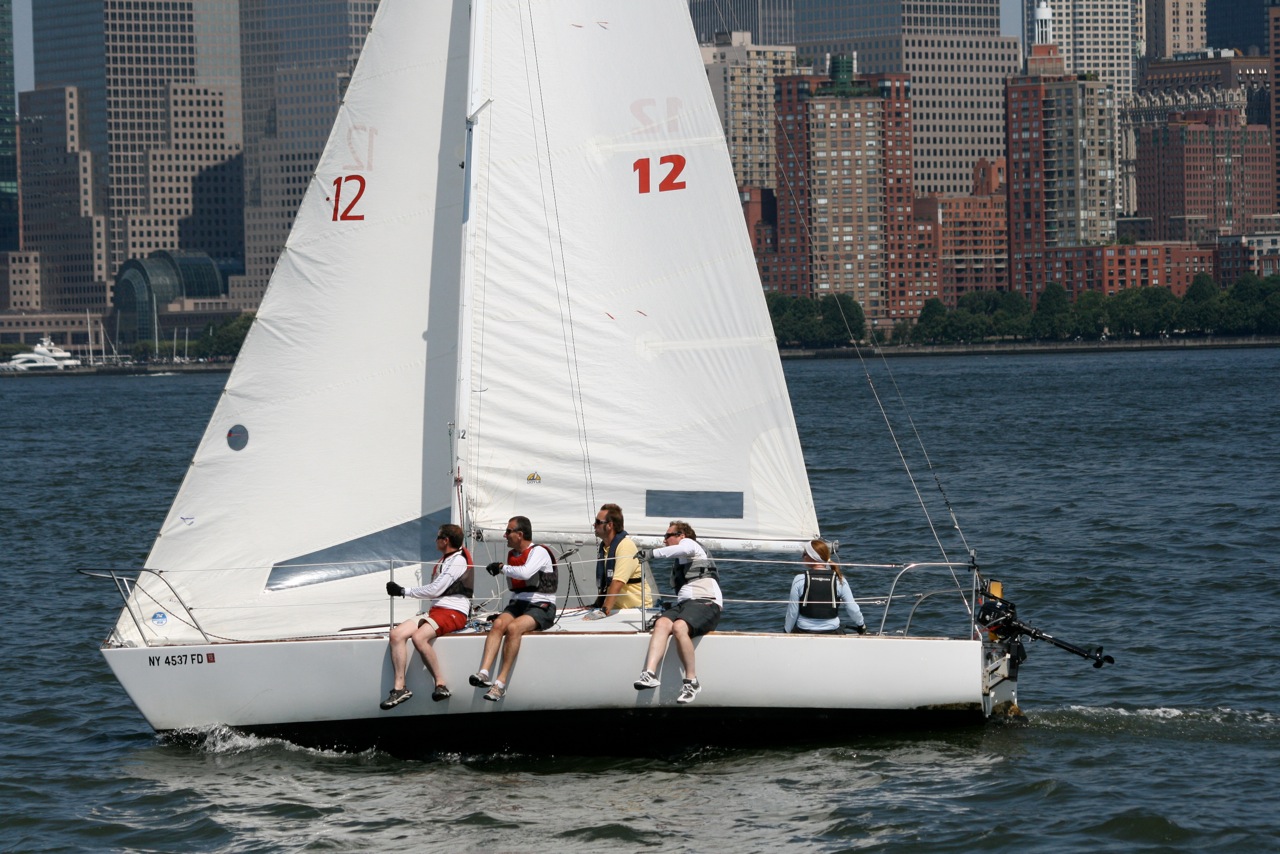
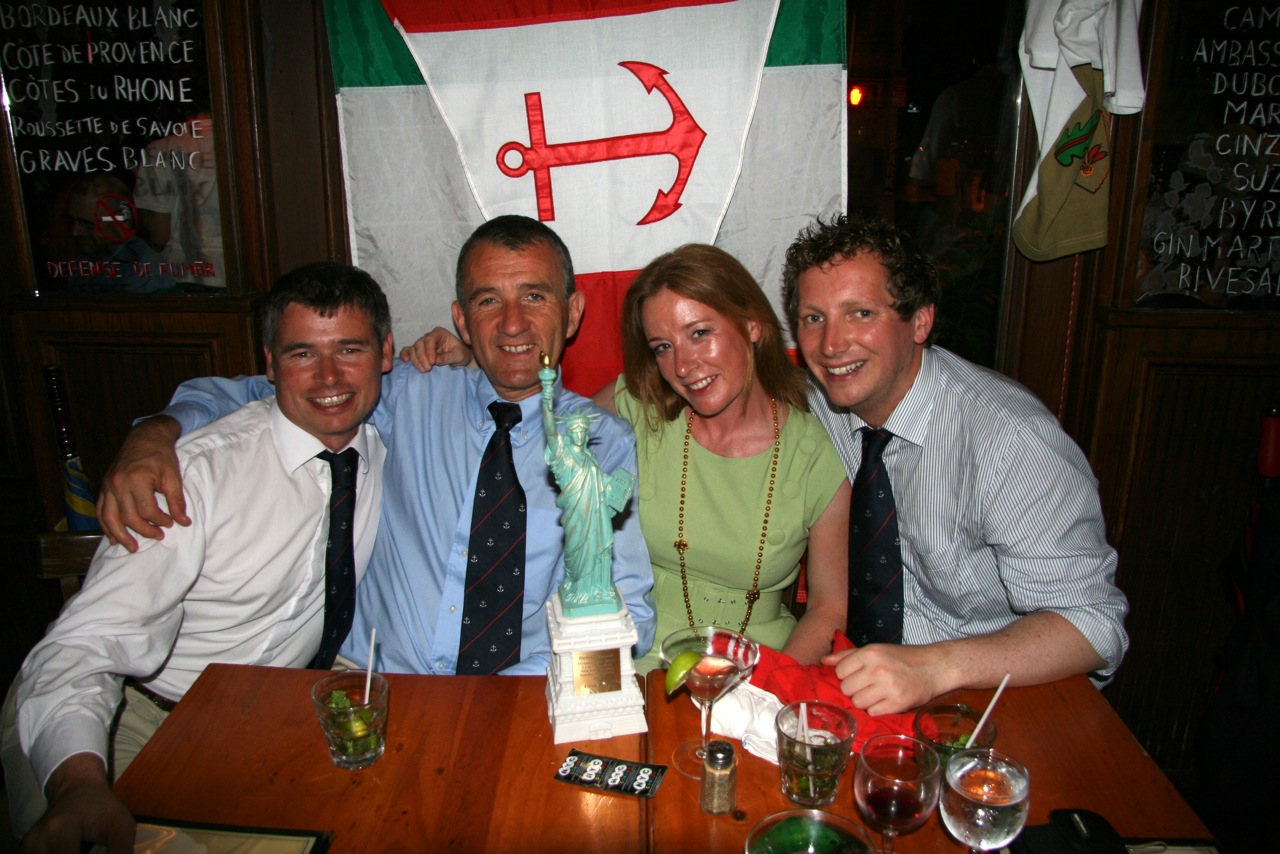
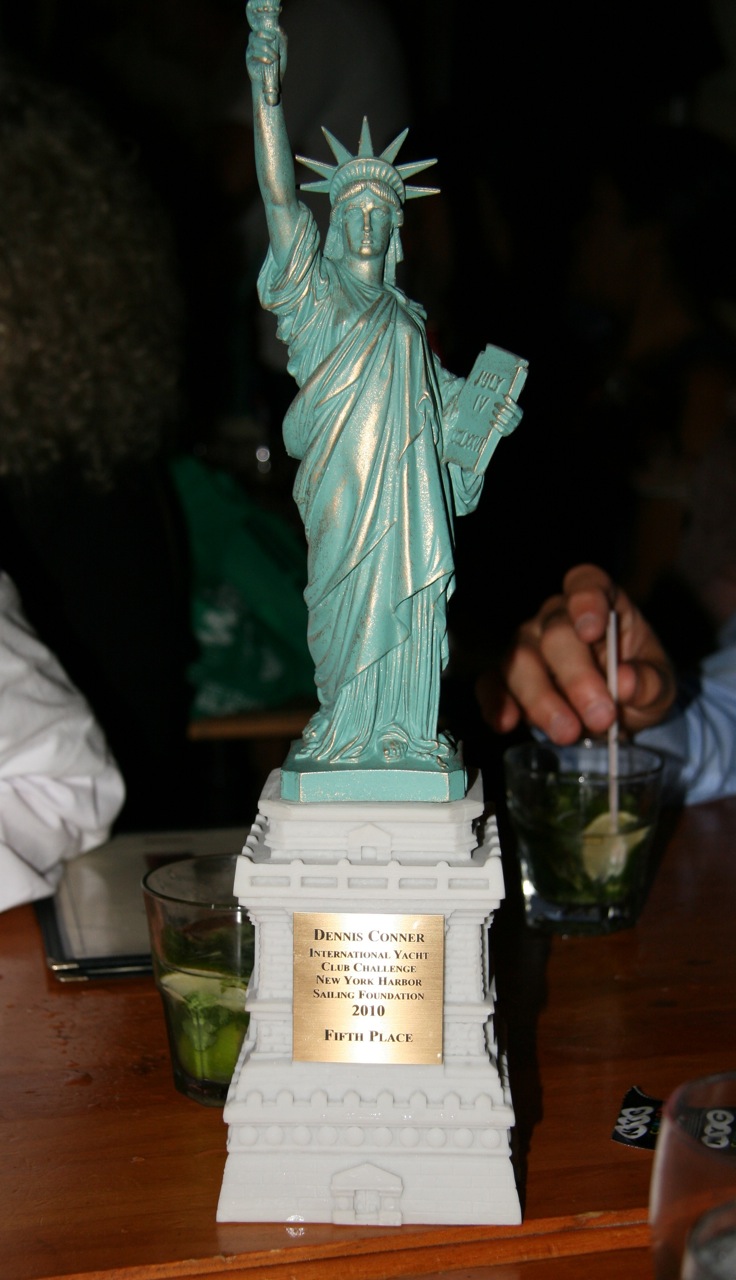
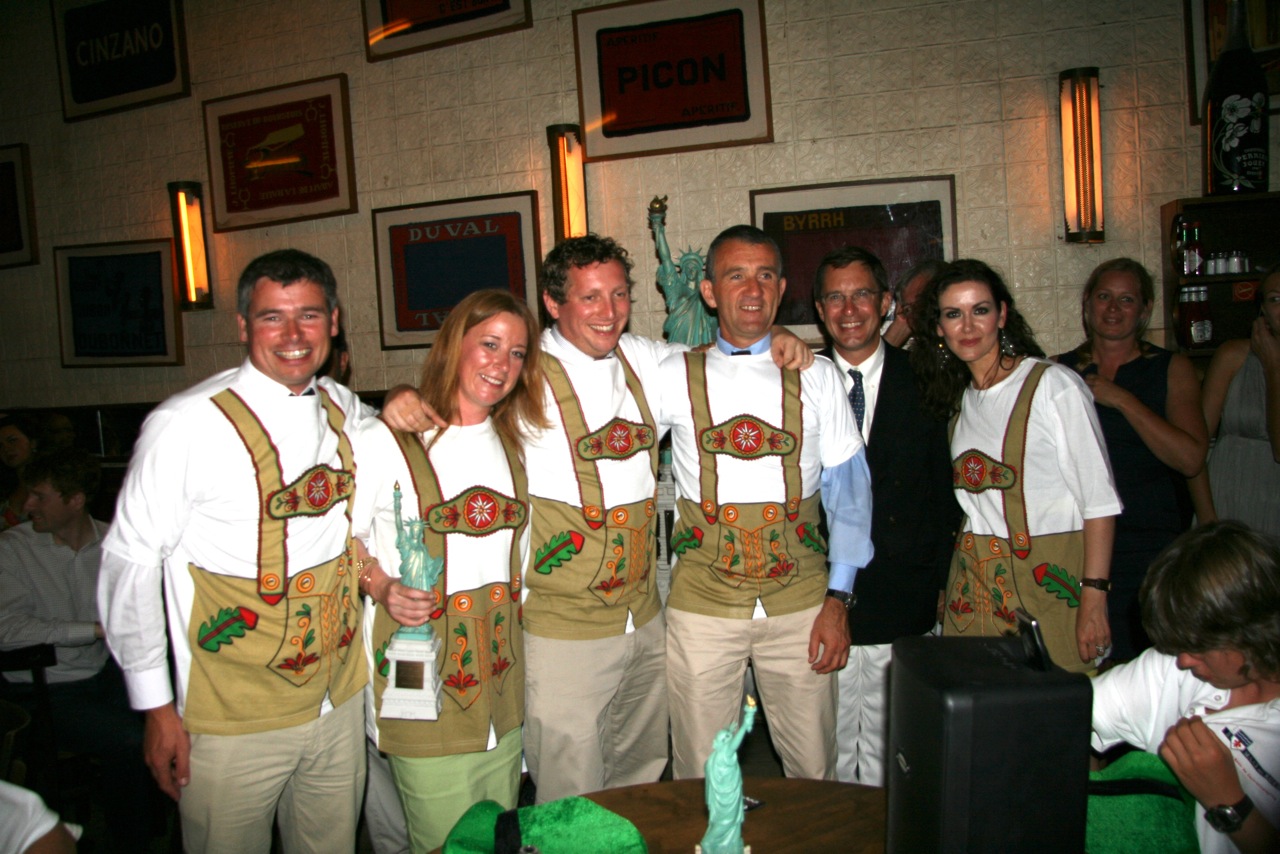
Sun Shines on J24 Western Championships
"Lough Ree always had the water and the boats - They just needed the weather!" was the comment from Commodore of Lough Ree Yacht Club; Frank Murray.
Summer certainly obliged with blue skies, blazing sunshine, 24 degrees and moderate breeze on the Saturday 19th June and 27 degrees and light breeze on the Sunday 20th June for the J24 Western Championship 2010 held this year in Lough Ree Yacht Club.
Principal Race Officer for the Event; Derek Bothwell ran 6 windward/leeward races for the 16 boat fleet with notable visitors to Lough Ree of Stefan Hyde on "Nautigirl", Brian McDowell on "Scandal", Robin Eagleson in "Luder Too", Michael McCaldin, "Murder Picture", Flor O'Driscoll on "Hard on Port" and Emma McDonald who had never sailed a J24 prior to this event, borrowed local boat "Jaws".
Very close racing ensued with Flor ODriscoll taking the over all championship on 12 points, with local, Andrew Mannion in "Jeb Stuart" taking 2nd place on 16 points and first time J24 sailor Emma McDonald from Howth in 3rd place just one point behind.
A fantastic regatta that will be remembered for the hospitality of Lough Ree Yacht Club, the great racing and strangely for Ireland the fantastic summer weather.
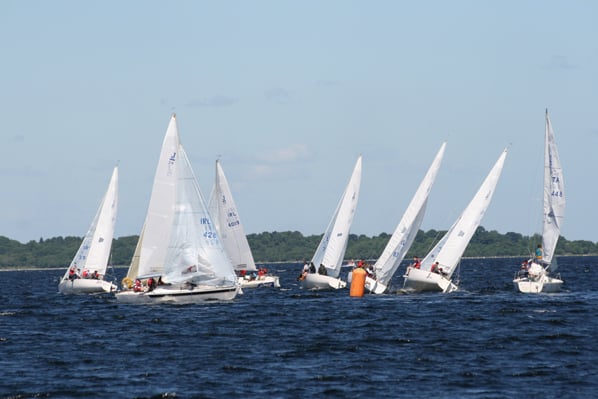
Tight racing at the Leeward Mark - Lough Ree
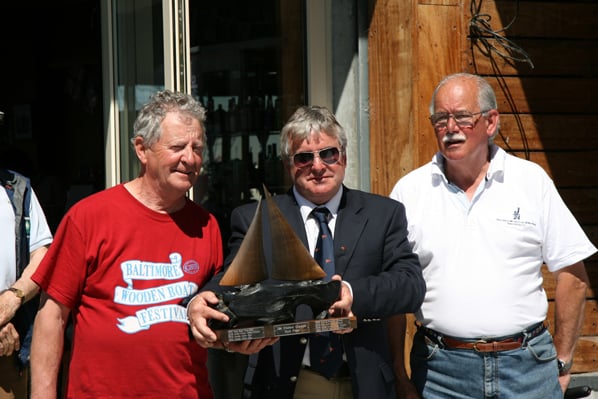
L-R - Flor O'Driscoll, J24 Western Champion 2010, Frank Murray, Commodore LRYC, Robin Eagleson, President, IJCA-IRL
Photos courtesy of Alison Miles


























